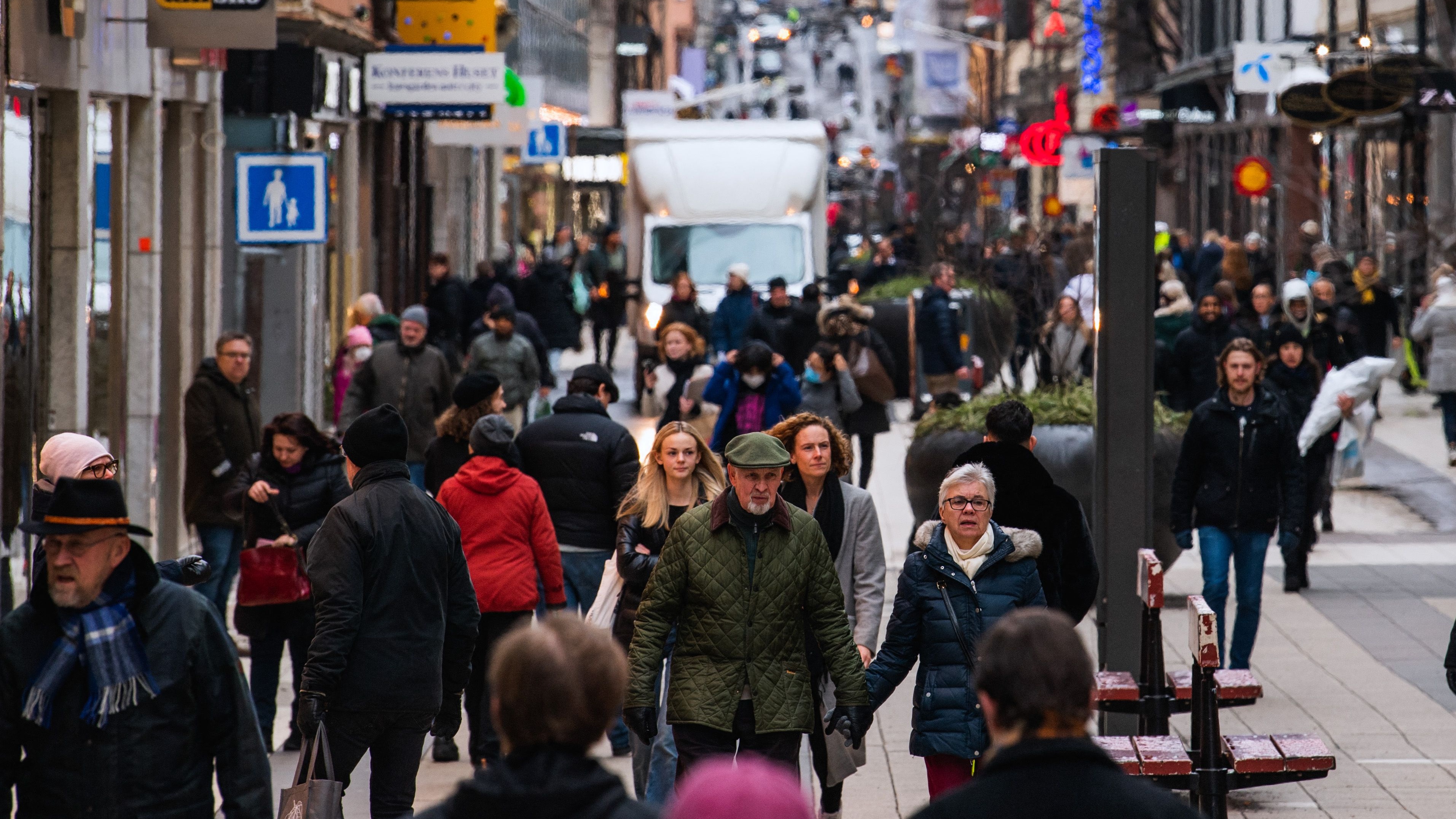Did Sweden’s Covid-19 experiment pay off in the end?
Scandinavian country had lower excess death rate than many but immigrants and elderly bore the brunt

Sweden is heading to the polls this weekend for its first general election since the pandemic, but the country’s response to Covid has gone largely unmentioned.
It “made headlines when it refused to implement draconian measures as other countries around the world went into lockdown”, said AFP, via US weekly Barron’s, but the subject is now “notably absent” from campaigning.
In the first ballot “since these life or death decisions were made, it is almost as if Covid never happened”, said The Guardian. Leaders across the spectrum in a tight race are instead focusing on “crime, immigration and energy prices but not Covid”.
The Week
Escape your echo chamber. Get the facts behind the news, plus analysis from multiple perspectives.

Sign up for The Week's Free Newsletters
From our morning news briefing to a weekly Good News Newsletter, get the best of The Week delivered directly to your inbox.
From our morning news briefing to a weekly Good News Newsletter, get the best of The Week delivered directly to your inbox.
This has left health experts “disappointed by the lack of attention the pandemic is receiving” and fearing that “lessons will not be learned from the vulnerabilities it exposed in Swedish society”, especially its impact on immigrants and the elderly, said the paper.
Death rates
Sweden had one of Europe’s lowest Covid-19 death rates despite shunning most lockdown restrictions, data released in May by the World Health Organization (WHO) suggested. It covered global excess deaths associated with Covid-19 from January 2020 to December 2021.
Stockholm chose not to implement a full national lockdown during the pandemic, instead relying on “voluntary changes to behaviour”, said The Telegraph. The decision meant the nation was “deemed almost to be a rogue state” as other countries introduced wide-ranging restrictions to stem the spread of the virus.
But according to the WHO figures, Sweden had an excess death rate of 56 per 100,000 – well below the global average of 96. By comparison, between 2020 and 2021, the UK’s excess death rate was 109, Spain’s was 111, and Germany’s was 116.
A free daily email with the biggest news stories of the day – and the best features from TheWeek.com
Light-touch approach
At the beginning of the pandemic, Sweden’s public health officials argued that it would “take years” to see which approaches to combating Covid-19 would be most effective, The Telegraph reported, arguing it would be better to avoid “untested measures”.
They also took into consideration the “collateral damage” of lockdown, such as “the missed cancer diagnoses, the cancelled hospital appointments, and the lost education”, the paper said. And the decision “appears to have been vindicated”.
Sweden relied on individual citizens’ sense of “civic duty” to protect its population, said the Daily Mail, with authorities advising the population to practise social distancing while schools, bars and restaurants remained open to the public.
The decision to keep primary schools open “paid off”, said Emma Frans, a senior research specialist at the C8 Department of Medical Epidemiology and Biostatistics at Stockholm’s Karolinska Institutet, writing on The Conversation.
“The incidence of severe acute Covid in children has been low” and a study showed that Swedish children “didn’t suffer the learning loss seen in many other countries”, she said.
Important factors
Experts have suggested that socio-demographic factors could have played a huge part in keeping down excess deaths, meaning that the policy of shunning formal lockdowns may not have worked equally well in other countries.
These factors include “having a high rate of single-person households”, therefore reducing opportunities for transmission, as well as a “low population density compared to countries such as the UK and Italy”, said the Daily Mail.
Economic impact
At the end of the first wave of the pandemic in 2020, the International Monetary Fund (IMF) predicted that Sweden’s economy would shrink by 7%. This proved to be a pessimistic forecast, with the country’s economy shrinking by just 2.8%, “significantly lower” than the EU average of 6% and the UK’s “staggering” 9.8%, said The Telegraph.
Sweden’s economy bounced back from the pandemic faster than any country in Europe, although - like many other countries - its growth is expected to slow, to 2.2% this year and 1% in 2023, according to the OECD.
Its initial strong economic performance was in part due to its pandemic response, but also its “heavy reliance on industry” and its “smaller services sector”, said Reuters.
Neighbourhood comparison
While Sweden’s death figures are lower than many European nations, comparing its figures to other Nordic countries shows you “cannot call Sweden a success”, Professor Paul Hunter, an epidemiologist at the University of East Anglia, told the Daily Mail.
He added that it was “always difficult” to compare countries because excess mortality is affected by “many more things” than just Covid policy, such as health expenditure.
Sweden’s neighbours fared significantly better in keeping excess death rates down, with Denmark logging just 32 excess deaths per 100,000, while Norway logged “one fewer death per 100,000 than expected”, said the paper.
And while Sweden’s excess death rate may look “flattering relative to the majority of EU countries”, the WHO report is unlikely to settle many arguments on which countries took the best approach to the pandemic, said François Balloux, director of the University College London Genetics Institute, in The Guardian.
This is because excess deaths are “difficult to measure precisely”, he wrote, adding that the data “paints a complex picture supporting no single straightforward narrative”.
A single figure for each country does not “capture the full complexity of vastly different socioeconomic situations and two years of inconsistent policies”. But the “stringency of mitigation measures” does not appear to be a “strong predictor of excess deaths”.
Overall, the May WHO report pointed to the importance of “reducing inequality, improving health and providing a robust social and healthcare system offering the best pandemic preparedness”, Balloux added, which may also explain Sweden’s relative success.
Failed groups
In late 2020, the Corona Commission, an independent committee appointed by the government to evaluate the Swedish pandemic response, found leaders had largely failed in their ambition to protect the elderly, noted Frans at The Conversation. At that time, almost 90% of those who had died with Covid in Sweden were 70 or older.
Meanwhile, Göran Stiernstedt, a member of Sweden’s coronavirus commission and associate professor of infectious disease at the Karolinska Institute, noted the disproportionate effect the pandemic had on immigrant groups. Stiernstedt told The Guardian that the crisis “really exposed that the risk for people born outside Europe was much greater than those born in Sweden”.
-
 Who is paying for Europe’s €90bn EU loan?
Who is paying for Europe’s €90bn EU loan?Today’s Big Question Kyiv secures crucial funding but the EU ‘blinked’ at the chance to strike a bold blow against Russia
-
 Quiz of The Week: 13 – 19 December
Quiz of The Week: 13 – 19 DecemberQuiz Have you been paying attention to The Week’s news?
-
 What’s causing the non-fiction slump?
What’s causing the non-fiction slump?In the Spotlight Readers are turning to crime fiction, romantasy and self-help books as a form of escapism
-
 Covid-19 mRNA vaccines could help fight cancer
Covid-19 mRNA vaccines could help fight cancerUnder the radar They boost the immune system
-
 The new Stratus Covid strain – and why it’s on the rise
The new Stratus Covid strain – and why it’s on the riseThe Explainer ‘No evidence’ new variant is more dangerous or that vaccines won’t work against it, say UK health experts
-
 RFK Jr. vaccine panel advises restricting MMRV shot
RFK Jr. vaccine panel advises restricting MMRV shotSpeed Read The committee voted to restrict access to a childhood vaccine against chickenpox
-
 RFK Jr. scraps Covid shots for pregnant women, kids
RFK Jr. scraps Covid shots for pregnant women, kidsSpeed Read The Health Secretary announced a policy change without informing CDC officials
-
 New FDA chiefs limit Covid-19 shots to elderly, sick
New FDA chiefs limit Covid-19 shots to elderly, sickspeed read The FDA set stricter approval standards for booster shots
-
 RFK Jr.: A new plan for sabotaging vaccines
RFK Jr.: A new plan for sabotaging vaccinesFeature The Health Secretary announced changes to vaccine testing and asks Americans to 'do your own research'
-
 Five years on: How Covid changed everything
Five years on: How Covid changed everythingFeature We seem to have collectively forgotten Covid’s horrors, but they have completely reshaped politics
-
 HMPV is spreading in China but there's no need to worry
HMPV is spreading in China but there's no need to worryThe Explainer Respiratory illness is common in winter